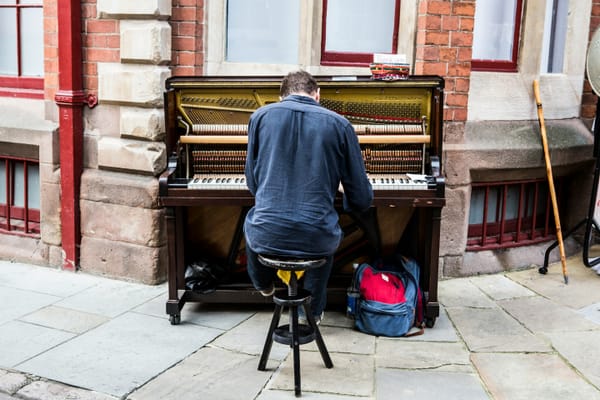Magnus and his wall
A ragged V-formation of large dark birds winged earnestly southwards, contrasting starkly against the thin white cloud cover that had rolled in from the Arctic across the skies of Seydisfjordur. The weather in the northern fjords of Iceland was fickle at best, but today the tops of the nearby mountains could still be observed – remnants of snow lay randomly spread above the scree line like a dusting of icing sugar on a dark fruit cake. Below, the chilled ocean was broken into a small chop by a nagging wind in the tiny harbour as a small asthmatic steam-powered vessel returned safely to port towing three recently harpooned minke whales. Several arctic terns silently criss-crossed its bloody wake. There would be celebrations in the town this evening when the flensing of the carcasses began because minkes had avoided this part of the Arctic this season. Magnus Egilsson, the mayor of Seydisfjordur, would possibly have been less drawn to celebration if he’d had an inkling of other bodies in the harbour.
When Magnus had initially sought funding from the Government in Reykjavik for the building of a groyne in the harbour of his town, there had been some resentment from small-time fishermen. The groyne stretched outwards across the shallows at the head of the fjord and impeded access to their cooperative, but Magnus Egilsson had grand visions for his town as they entered the 1920s. He believed that a deeper water access would encourage larger steamers and whalers. Not given to compromise, Magnus forged ahead with his plan and today a total of 150 metres of rock wall stretched outwards from the harbour. For its construction, a small steam engine had been brought to the town by ship and barge and a temporary rail track stretched outwards along the wall to transport the necessary rocks and concrete on an open carriage.
But local fishermen weren’t the only antagonists. The huldufolk weren’t happy with the construction of the wall and the scar it tore into the fjord. It’s difficult to reason with supernatural beings when they’re invisible, much less prevent them from saboutaging important projects such as this which Magnus had forged ahead with despite the reservations of many townspeople. As all Icelandic people know, the huldufolk are an unseen people who share this world, existing in an alternative reality, but living all around us. They are very sensitive to the beauty and pristine qualities of nature, and are responsible for many of the hiccups which occur in building projects that upset the natural environment. For the past two years, Magnus’ wall had faced many setbacks which were popularly attributed to the huldufolk, but nothing was allowed to interrupt today.
Magnus glowed with self-importance as he surveyed the 150 metres of track and rock wall that stretched before him. He had donned his only suit for this event. His wife, Ragna Gunnarsdottir, was bedecked in her best Sunday dress and a dozen or more dignitaries from Seydisfjordur and two members of the Icelandic government were also suitably dressed. This was a triumphant moment for Magnus; the assembled group would stand on the open carriage and be shunted out the length of the wall by the steam engine for the official opening by an Icelandic politician from Reykjavik. It was to be a great day for Seydisfjordur and an even greater day for Magnus Egilsson. Perhaps there would be a political life in his future.
It’s questionable whether the huldufolk bore any responsibility but halfway out the wall, Brondolfur the steam engineer felt a sudden decrease in his own blood pressure. The important folk celebrating in the open carriage ahead of him, who were suitably charged with shots of Brennivin despite Iceland’s prohibition laws, changed noticeably from sharp images to out-of-focus in a few seconds, and as he was overwhelmed with giddiness he struggled to avoid fainting. This wasn’t apparent to the revellers in the open carriage because all eyes were focused down the track ahead of them and the freezing Arctic waters of the fjord which lay just beyond. The engineer barely managed to retain consciousness as he approached the end of the line and fumbled weakly for the controls much too late. The official party realised they were in trouble and directed a huge cacaphony of shrieking and screaming backwards towards Brondolfur who was slowly receiving enough blood in his brain to release the pressure valve and apply the brakes. Much too late, the open carriage slammed through the ineffective buffer at track’s end and the bogey wheels quickly jammed into the bed of small rocks just at the end of the wall. The sudden stop from 20kph ensured that momentum took over. In the history of Iceland’s more hilarious events, the entire passenger manifest on the open carriage was catapulted raucously and inelegantly into the frigid waters of the fjord. Fortunately all were close to the rock wall and able to swim or be dragged to safety.
Much to the embarrassment of Magnus and the politicians, the newspapers in Reykjavik had a field day. Whilst the unseen huldufolk had seemingly won this skirmish, they had lost the war. To them, Magnus’ wall would forever be a daily poke in the eye to aesthetic beauty and natural order.


